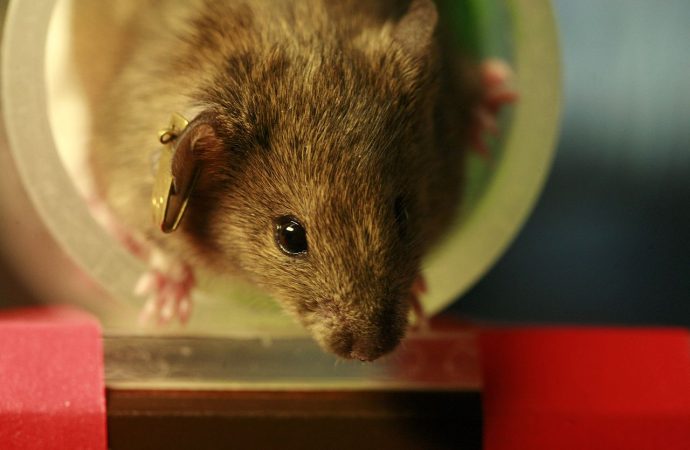The use of mice in biomedical research dates back to the 16th century, when William Harvey used them to study blood circulation. Ever since, no other animal has had such a great impact on scientific research. In fact, alongside rats, mice represent around 95% of animals used in laboratories around the world.
Until now, every single mouse used in laboratories went through a very meticulous process of handling and care in secured animal facilities. Strict international legislation state that mice have to be “provided with humane care and healthful conditions during their stay” in those facilities. Also, lab mice are usually subjected to a process of selective breeding to assure their genetic homogeneity, in order to make it possible to compare and replicate different experimental data.
On top of that, since they are kept in extremely sanitized facilities, lab mice are free from pathogens that commonly determine and shape human’s immunological system and therefore, are extremely susceptible to microorganism’s attacks. Thus, it is commonly accepted that, while mice might be the best models to study human diseases, they are far from accurately mimicking the human body environment. In particular, the differences between mice and human’s immune system are greatly significant.
Different immune systems
Intrigued by these differences in humans and mice’s immune systems, David Masopust and his team assessed the presence of memory T cells in both human and mice tissues. Memory T cells are a specialized subset of cells that keep a record of previous infections by microorganisms and act quickly to protect the body against a second infection. Thus, the higher the number of these specialized cells, the stronger the ability to fight infections.
The team concluded that, not surprisingly, adult human’s tissues were strongly populated with specialized immune cells. In contrast, they found that these cells were practically absent in lab mice’s tissues. Moreover, when comparing lab mice with newborn humans, Masopust concluded that their specialized T cell levels were quite similar, likely because both human babies and lab mice have little contact with pathogens in the environment.
“Dirty” cage-mates make “clean” mice stronger
Having proved that mice and human’s immune systems are indeed different, the next step was to understand whether those differences are intrinsic to all mice or specific to “pathogen-free” mice. To study this, Masopust decided to break the sacred rules of animal handling, by bringing wild mice into his lab and co-housing them with ‘clean’ lab mice.
After 8 weeks of co-housing, more than 20% of ‘clean’ mice died, because they were too weak to kill pathogens carried by wild ‘dirty’ mice. However, the co-housed mice who did survive quickly developed a strong immune system: the levels of specialized T cells were now much higher and, most importantly, co-housed mice were able to strongly fight infections, compared to the “clean” mice kept in sterilized cages.
[su_custom_gallery source=”media: 52870,52877″ link=”image” width=”370″ height=”350″]
Testing the “Hygiene Hypothesis”
Masopust’s study confirms that “it may be opportune to add ‘dirty’ mice to the repertoire of investigative tools” in laboratories, in order to “normalize” lab mice’s immune systems. Nevertheless, as many flaws as the current lab mice models might have, they are still irreplaceable tools for researchers. For instance, the process of breeding selection, that renders lab mice extremely susceptible to infections, is the key to achieve reproducibility and comparability of experimental results. And the logistics of bringing “dirty” animals into clean animal facilities are not easy. Masopust’s team had to request a special authorization to bring wild and pet-sore mice into their laboratory’s animal facilities.
The challenges of implementing “dirty” mice in laboratories are huge, but so are the possibilities. For now, Masopust’s team wants to use these mice to test the “hygiene” hypothesis: the idea that the increase in certain immune disorders, such as asthma, is the result of low environmental exposure to microorganisms during childhood. On the long run, they hope to create a better solution to translate mice studies’ results to human clinical trials. While other groups struggle to create alternatives to animal testing, Masopust’s studies show that laboratory mice are here to stay.
References
Beura, L., Hamilton, S., Bi, K., Schenkel, J., Odumade, O., Casey, K., Thompson, E., Fraser, K., Rosato, P., Filali-Mouhim, A., Sekaly, R., Jenkins, M., Vezys, V., Haining, W., Jameson, S., & Masopust, D. (2016). Normalizing the environment recapitulates adult human immune traits in laboratory mice Nature, 532 (7600), 512-516 DOI: 10.1038/nature17655
Mestas, J., & Hughes, C. (2004). Of Mice and Not Men: Differences between Mouse and Human Immunology The Journal of Immunology, 172 (5), 2731-2738 DOI: 10.4049/jimmunol.172.5.2731
Shultz, D. (2016). Can ‘dirty mice’ save animal research? Science DOI: 10.1126/science.aaf4153
Reardon, S. (2016). Dirty room-mates make lab mice more useful Nature, 532 (7599), 294-295 DOI: 10.1038/532294a
APA guidelines





